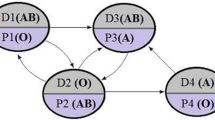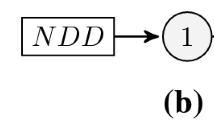Abstract
The traditional concept of barter exchange in economics has been extended in the modern era to the area of living-donor kidney transplantation, where one incompatible donor-candidate pair is matched to another pair with a complementary incompatibility, such that the donor from one pair gives an organ to a compatible candidate in the other pair and vice versa. Kidney paired donation (KPD) programs provide a unique and important platform for living incompatible donor-candidate pairs to exchange organs in order to achieve mutual benefit. In this paper, we propose novel organ allocation strategies to arrange kidney exchanges under uncertainties with advantages, including (i) allowance for a general utility-based evaluation of potential kidney transplants and an explicit consideration of stochastic features inherent in a KPD program; and (ii) exploitation of possible alternative exchanges when the originally planned allocation cannot be fully executed. This allocation strategy is implemented using an integer programming (IP) formulation, and its implication is assessed via a data-based simulation system by tracking an evolving KPD program over a series of match runs. Extensive simulation studies are provided to illustrate our proposed approach.







Similar content being viewed by others
References
Abraham DJ, Blum A, Sandholm T (2007) Clearing algorithms for barter exchange markets: enabling nationwide kidney exchanges. In: Ec’07: proceedings of the eighth annual conference on electronic commerce, pp 295–304
Edmonds J (1965) Paths, trees, and flowers. Can J Math 17:449–467
Evans RW, Manninen DL, Garrison LP, Hart LG, Blagg CR, Gutman RA, Hull AR, Lowrie EG (1985) The quality of life of patients with end-stage renal disease. N Engl J Med 312(9):553–559
Hariharan S, Johnson CP, Bresnahan BA, Taranto SE, McIntosh MJ, Stablein D (2000) Improved graft survival after renal transplantation in the United States, 1988 to 1996. N Engl J Med 342(9):605–612
Keizer KM, de Klerk M, Haase-Kromwijk BJJM, Weimar W (2005) The Dutch algorithm for allocation in living donor kidney exchange. Transplant Proc 37(2):589–591
Laupacis A, Keown P, Pus N, Krueger H, Ferguson B, Wong C, Muirhead N (1996) A study of the quality of life and cost-utility of renal transplantation. Kidney Int 50(1):235–242
Maiers M, Gragert L, Klitz W (2007) High-resolution hla alleles and haplotypes in the United States population. Hum Immunol 68(9):779–788
Park K, Moon JI, Kim SI, Kim YS (1999) Exchange donor program in kidney transplantation. Transplantation 67(2):336–338
Rapaport FT (1986) The case for a living emotionally related international kidney donor exchange registry. Transplant Proc 18:5–9
Rees MA, Kopke JE, Pelletier RP, Segev DL, Rutter ME, Fabrega AJ, Rogers J, Pankewycz OG, Hiller J, Roth AE, Sandholm T, Ünver MU, Montgomery RA (2009) A nonsimultaneous, extended, altruistic-donor chain. N Engl J Med 360(11):1096–1101
Ross LF, Rubin DT, Siegler M, Josephson MA, Thistlethwaite JR, Woodle ES (1997) Ethics of a paired-kidney-exchange program. N Engl J Med 336(24):1752–1755
Roth AE, Sönmez T, Ünver MU (2004) Kidney exchange. Q J Econ 119(2):457–488
Roth AE, Sönmez T, Ünver MU (2005) A kidney exchange clearinghouse in new England. Am Econ Rev 95(2):376–380
Roth AE, Sönmez T, Ünver MU (2007) Efficient kidney exchange: coincidence of wants in markets with compatibility-based preferences. Am Econ Rev 97(3):828–851
Russell JD, Beecroft ML, Ludwin D, Churchill DN (1992) The quality of life in renal transplantation—a prospective study. Transplantation 54(4):656–660
Schaubel DE, Wolfe RA, Port FK (2006) A sequential stratification method for estimating the effect of a time-dependent experimental treatment in observational studies. Biometrics 62(3):910–917
Schaubel DE, Wolfe RA, Sima CS, Merion RM (2009) Estimating the effect of a time-dependent treatment by levels of an internal time-dependent covariate: application to the contrast between liver wait-list and posttransplant mortality. J Am Stat Assoc 104(485):49–59
Segev DL, Gentry SE, Warren DS, Reel B, Montgomery RA (2005) Kidney paired donation and optimizing the use of live donor organs. J Am Med Assoc 293(15):1883–1890
Shapley L, Scarf H (1974) On cores and indivisibility. J Math Econ 1(1):23–37
Terasaki PI, Cecka JM, Gjertson DW, Takemoto S (1995) High survival rates of kidney-transplants from spousal and living unrelated donors. N Engl J Med 333(6):333–336
Wolfe RA, Ashby VB, Milford EL, Ojo AO, Ettenger RE, Agodoa LYC, Held PJ, Port FK (1999) Comparison of mortality in all patients on dialysis, patients on dialysis awaiting transplantation, and recipients of a first cadaveric transplant. N Engl J Med 341(23):1725–1730
Wolfe RA, McCullough KP, Schaubel DE, Kalbfleisch JD, Murray S, Stegall MD, Leichtman AB (2008) Calculating life years from transplant (lyft): methods for kidney and kidney-pancreas candidates. Am J Transplant 8(4p2):997–1011
Acknowledgements
The authors thank the support from the Michigan Institute for Clinical and Health Research (MICHR), Michigan School of Public Health, Scientific Registry of Transplant Recipients, and National Institute of General Medical Sciences (NIGMS). The authors are also grateful for invaluable suggestions and comments from Drs. Yanhua Chen, David Abraham and Tuomas Sandholm. The authors would like to thank an anonymous referee whose comments helped to improve this manuscript. This work was supported in part by a grant from the National Institutes of Health (NIH) CTSA at the University of Michigan 2UL1TR000433-06 and by the NIH grant 1R01-DK093513.
Author information
Authors and Affiliations
Corresponding author
Additional information
This work was done while Yijiang (John) was a Ph.D. candidate in the Department of Biostatistics, University of Michigan.
Appendix: Edge Formulation
Appendix: Edge Formulation
Let Y ij be a decision variable for each \((i,j) \in\mathcal{E}\), such that Y ij is 1 if edge (i,j) is chosen for a transplant and 0 otherwise. When no restriction is placed on the length of an exchange cycle, we solve the following IP problem:

This IP problem could be solved efficiently in polynomial time by finding a maximum weight perfect matching. If the exchange cycle length is restricted to be at most k, an additional set of constraints has to be added, i.e.

The number of additional constraints in (2), even when k=3, is usually enormously large in a realistic KPD program with several hundred incompatible pairs, which makes it impossible to even store all the constraints in a typical IP solver such as CPLEXFootnote 1 or Gurobi.Footnote 2 Therefore, in this case, the cycle formulation presented in Sect. 2.2 is preferred.
Rights and permissions
About this article
Cite this article
Li, Y., Song, P.XK., Zhou, Y. et al. Optimal Decisions for Organ Exchanges in a Kidney Paired Donation Program. Stat Biosci 6, 85–104 (2014). https://doi.org/10.1007/s12561-013-9082-0
Received:
Accepted:
Published:
Issue Date:
DOI: https://doi.org/10.1007/s12561-013-9082-0




